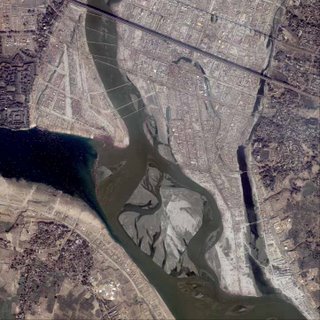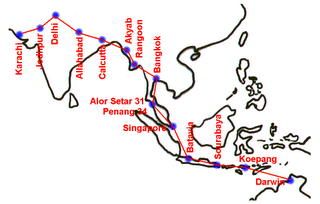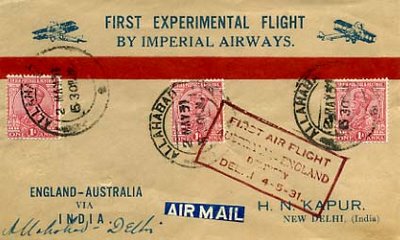Allahabad or Prayagraj is a historian's paradise. History lies embedded everywhere, in its fields, forests and settlements. Forty-eight kilometres, towards the southwest, on the placid banks of the Jamuna, the ruins of Kaushambi, capital of the Vatsa kingdom and a thriving center of Buddhism, bear silent testimony to a forgotten and bygone era. On the eastern side, across the river Ganga and connected to the city by the Shastri Bridge is Jhusi, identified with the ancient city of Pratisthanpur, capital of the Chandra dynasty. About 58 kilometres northwest is the medieval site of Kara with its impressive wreckage of Jayachand's fort. Sringverpur, another ancient site discovered relatively recently, has become a major attraction for tourists and antiquarians alike.
Prayag is an extremely important and integral part of the Ganga Yamuna Doab, and its history is inherently tied with that of the Doab region, right from the inception of the town.
The city was known earlier as Prayāga - a name that is still commonly used. That it is an ancient town, is illustrated by references in the Vedas (circa 1500 B.C.) to Prayag, where Brahma, the Hindu Creator of the Universe, is believed to have attended a sacrificial ritual. Excavations have revealed Northern Black Polished ware objects in Prayag, further corroborating the conjecture that Prayag existed as a town as early as 1100 B.C.
When the Aryans first settled in what they termed the Aryavarta, or Madhyadesha, Prayag or Kaushambi was an important part of their territory. The Vatsa (a branch of the early Indo-Aryans) were rulers of Hastinapur (near present day Delhi), and they established the town of Kaushambi near present day Prayag. They shifted their capital to Kaushambi when Hastinapur was destroyed by floods.
In the times of the Ramayana, Prayag was made up of a few rishis' huts at the confluence of the sacred rivers, and much of the vats country was continuous jungle. Lord Rama, the main protagonist in the Ramayana, spent some time here, at the Ashram of Sage Bharadwaj, before proceeding to nearby Chitrakoot.
The Doaba region, including Prayag was controlled by several empires and dynasties in the ages to come. It became a part of the Mauryan and Gupta empires of the east and the Kushan empire of the west before becoming part of the local Kannauj empire which became very powerful.
Objects unearthed in Prayag indicate that it was part of the Kushana empire in the 1st century AD. In his memoirs on India, Huien Tsang, the Chinese chronicler who travelled through India during Harshavardhana's reign (A.D. 607-647), writes that he visited Prayag in A.D. 643.
When the Muslim rule came, Prayag became a part of the Delhi Sultanate when the town was annexed by Mhd Ghori in A.D. 1193. Then the Mughals took over from the slave rulers of Delhi and under them Prayag rose to prominence once again.
Acknowledging the strategic position of Prayag in the Doaba or the "Hindostan" region, at the confluence of its defining rivers which had immense navigational potentials, Akbar built a magnificent fort – one of his largest – on the banks of the holy Sangam and re-christened the town as Illahabad in 1575. (The Akbar fort has an Ashokan pillar and some temples, and is largely a military barracks. On the southwestern extremity of Prayag lies Khusrobagh that antedates the fort and has three mausoleums, including that of Jehangir's first wife – Shah Begum.)
It was from Prayag that Prince Salim, later to become emperor Jehangir, revolted against his father, the Mughal emperor Akbar. In 1602, prince Salim held a parallel imperial court in Akbar's fort here, ignoring the royal summons to leave Prayag and proceed to Agra. However, before his death in 1605, Akbar named Salim his successor.
Before colonial rule was imposed over Prayag, the city was rocked by Maratha incursions. But the Marathas also left behind two beautiful eighteenth century temples with intricate architecture.
In 1765, the combined forces of the Nawab of Awadh and the Mughal emperor Shah Alam lost the war of Buxar to the British. Although, the British did not take over their states, they established a garrison at the Prayag fort --- realising its strategic position as the gateway to the north west. Governor General Warren Hastings later took Prayag from Shah Alam and gave it to Awadh alleging that he had placed himself in the power of the Marathas.
In 1801 the Nawab of Awadh ceded the city to the British East India Company. Gradually the other parts of Doaba and adjoining region in its west (including Delhi and Ajmer-Mewara regions) were won by the British. When these north western areas were made into a new Presidency called the "North Western Provinces of Agra", its capital was Agra. Prayag remained an important part of this state.
In 1834, Prayag became the seat of the Government of the Agra Province and a High Court was established. But a year later both were relocated to Agra.
In 1857,Prayag was active in the Indian Mutiny. After the mutiny, the British truncated the Delhi region of the state, merging it with Punjab and transferred the capital of North west Provinces to Prayag, which remained so for the next 20 years.
In 1877 the two provinces of Agra (NWPA) and Awadh were merged to form a new state which was called the United Provinces. Prayag was the capital of this new state till the 1920s.
An ancient seat of learning
It was a well-known centre of education (dating from the time of the Buddha), and in the first few decades of the 20th century. Allahabad University was established on 23rd September 1887. it is the fourth oldest university of India after Calcutta, Bombay and Madras University. In the 19th century, the Allahabad University earned the epithet of 'Oxford of the East'. Its jurisdiction at the time extended over a large part of north and north west India (today's U.P, Delhi, Haryana, Rajasthan and M.P.). Between 1887 and 1927 at least thirty-eight different institutions and colleges of this area were affiliated to Allahabad University. Allahabad University is also a major literary centre for Hindi. It also holds the world record for the world's first letter delivered by airmail (from Prayag to Naini, just a few km. across the river Yamuna) (1911).
Prayag's role in the freedom struggle
During the 1857 rebellion there was an insignificant presence of European troops in Prayag. Taking advantage of this, the rebels brought Prayag under their control. It was around this time that Maulvi Liaquat Ali Khan unfurled the banner of revolt. Long after the mutiny had been quelled, the establishment of the High Court, the Police Headquarters and the Public Service Commission, transformed the city into an administrative center, a status that it enjoys even today.
The fourth session of the Indian National Congress was held in the city in 1888. At the turn of the century Prayag also became a nodal point for the revolutionaries. The Karmyogi office of Sundar Lal in Chowk sparked patriotism in the hearts of many young men. Nityanand Chatterji became a household name when he hurled the first bomb at the European club. During the movement for independence, Prayag was at the forefront of all political activities. Alfred Park in Prayag was the site where, in 1931, the revolutionary Chandrashekhar Azad killed himself when surrounded by the British Police. Anand Bhavan, and an adjacent Nehru family home, Swaraj Bhavan, were the center of the political activities of the Indian National Congress. In the climactic years of the freedom struggle, thousands of satyagrahis, led, inter alia, by Purshottam Das Tandon, Bishambhar Nath Pande and Narayan Dutt Tewari, went to jail. And when freedom finally came, the first Prime Minister of free India, Jawahar Lal Nehru, and Union ministers like Mangla Prasad, Muzaffar Hasan, K. N. Katju, Lal Bahadur Shastri, all were from Prayag.
Prayag was the birthplace of Jawaharlal Nehru, and the Nehru family estate, called the Anand Bhavan, is now a museum. It was also the birthplace of his daughter Indira Gandhi, and the home of Lal Bahadur Shastri, both later Prime Ministers of India. In addition Vishwanath Pratap Singh and Chandra Shekhar were also associated with Prayag. Thus Prayag has the distinction of being the home of several Prime Ministers in India's post-independence history.
The first seeds of the idea of Pakistan were also sown in Prayag. On 29 December 1930, Allama Muhammad Iqbal's presidential address to the All-India Muslim League proposed a separate Muslim state for the Muslim majority regions of India.
Reorganisation of Prayag
Prayag division and the district was majorly reorganised a few years ago.and teh city was renamed again as Prayag.
The Etawah and Farrukhabad districts of the Prayag division were merged with the Agra division, while Kanpur dehat was carved out from the Kanpur district and a separate Kanpur division was created.
Parts of the western areas of Prayag were carved out to create a new district named Kaushambi. Now the new Prayag division consists of Prayag, Kaushambi and Fatehpur districts.
The Blog is dedicated to the City of Sangam "Allahabad" sitiuated on the banks of river Ganga, Yamuna and the mystical Saraswati.
Monday, November 20, 2006
Kumbha and Magh Mela

The word 'Mela' is fair in Hindi. Except in the years of the Kumbha Mela and the Ardha Kumbha Mela (Ardha is half in Hindi, hence the Ardha Kumbha Mela is held every 6th year), the Magh Mela takes place every year in the month of Magh (Jan - Feb) of the Hindu calendar. Kumbh Mela (the Urn Festival) occurs four times every twelve years and rotates between four locations: Prayag (Allahabad), Haridwar, Ujjain and Nashik.
The Sangam seen from shores of the Ganges River.In Allahabad, these religious fairs take place at the Sangam (confluence) of the Yamuna and the Ganges River which is holy in Hinduism. In the Kumbha Mela of 2001, which was called the Maha (great) Kumbha Mela because of an alignment of the Sun, Moon, and Jupiter that occurred only every 144 years, almost 75 million people visited the banks of the river to take part in the festivals. During the Melas, an entire township is built on the river's banks, with functioning hospitals, fire stations, police stations, restaurants and other facilities.
Monday, August 28, 2006
The Allahabad mail...

In April 1931, Imperial Airways planned two experimental airmails from London to Melbourne and return. This was the first official air mail between Great Britain and Australia.
Letters could be addressed to New Zealand and were accepted in New Zealand for the two return flights from Australia. Carriage between Australia and New Zealand was by sea. A major reason for the flight was that the Dutch had already established an air route from Amsterdam to the Dutch East Indies and were planning a flight to Australia.
The mail passed through Allahabad in the course of its journey.

The cover was flown from Allahabad to Delhi. It is postmarked 2 May 1931 and was flown to Delhi on 5 May. It was not backstamped.
Subscribe to:
Posts (Atom)